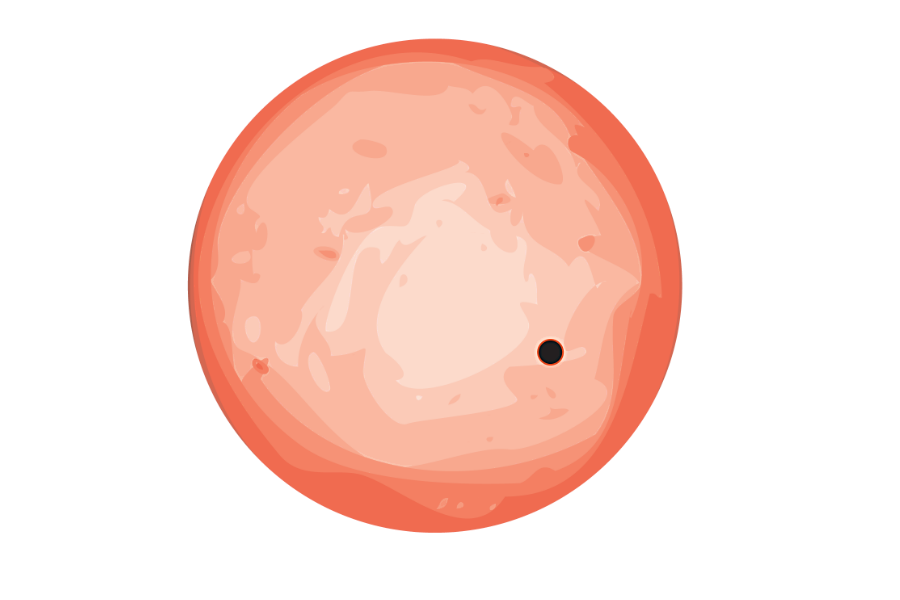Spotted: A rocky Earth-sized planet relatively close by
It's in space, it's made of rock, and it's hot, hot, hot.
Massachusetts Institute of Technology astronomers say they have discovered a new planet, and there's something familiar about it.
Much like our own planet, the new planet is rocky. It's also about the same size as Earth. And GJ 1132b, as it's been labeled, is remarkably close.
Some three times closer to our solar system than any other Earth-sized exoplanet found, GJ 1132b is just 39 light years away.
Sure, 39 light years seems like an insurmountable distance down on Earth. But considering the Milky Way galaxy stretches 100,000 light years across, "39 light years away is fairly nearby," MIT's Zachory K. Berta-Thompson, who led the team that spotted the planet, tells The Christian Science Monitor in an interview.
The new planet is about 1.2 Earth radii and about 1.6 times the mass of Earth, with a density similar to that of Earth. And, although the planet is similar in size and mass to our planet, "the similarities stop very quickly," says Dr. Berta-Thompson. "This planet is much hotter."
"It's hotter even than Venus [our solar system's hottest planet] because it's very close in to its star," he explains. "GJ 1132b is really close in. It receives about 20 times as much energy as the Earth receives from the Sun."
In fact, the upper atmosphere around GJ 1132b is nearly 500 degrees Fahrenheit. And it probably just gets hotter closer to the surface of the planet, Berta-Thompson says.
The planet also does not have days in the same way we do on Earth. Because GJ 1132b is so close to its star, and because the star is quite small (it has a radius one fifth that of our Sun), the planet experiences strong tides. The pull of the star "has actually yanked the planet into an orbit so that the planet always has one side facing toward the star and one side facing away from the star. That's what we call tidally locked," says Berta-Thompson.
As such, GJ 1132b is stuck with one side permanently in the day and the other in the night. "A world with a permanent day side and a permanent night side is going to look very different from the terrestrial planets that we have in our solar system," Berta-Thompson says.
The scientists spotted GJ 1132b by noticing a flicker of light. "We pointed our telescope at a relatively small, relatively nearby star and we noticed a little dip in light. That dip in brightness comes from the planet passing in front of its host star as seen from Earth," Berta-Thompson explains.
That dimming star actually told the scientists a lot about the planet. By noting how much light the GJ 1132b blocked, the researchers were able to calculate the size of the planet.
They also watched the gravitational pull of GJ 1132b on its star. From the way the planet made the small star wobble, the scientists were able to calculate the planet's mass. Using both size and mass, they could determine density too.
The density of a planet is key, because it tells you what that planet might be made of.
"If somebody hands you a birthday present or any wrapped package, you pick it up and you shake it," explains Berta-Thompson. "You feel how heavy it is to get a sense of what it is." By doing this, you're asking yourself, "does this have the density of a rock or does this have the density of feathers?"
Because their calculations revealed that GJ 1132b's density is similar to that of Earth's, Berta-Thompson says, "We're pretty confident that this planet is mostly rocky in its overall composition."
Since GJ 1132b is so close to our own solar system, the researchers hope to study it to learn more about similar planets and their solar systems.
Berta-Thompson plans to study GJ 1132b further by looking at features of the planet, like its atmosphere and dynamic climatic elements on its surface like winds. He also hopes to study the planet's solar system in a hunt for other planets. "It's possible that there's a habitable planet lurking far out in the GJ 1132 system that we just haven't detected yet," he says.
Although similar in size, mass and density to Earth, GJ 1132b is likely not habitable. "Based on everything we know, there's no way that you could have life on this planet," Berta-Thompson says. "It's too hot."
Could the perpetual night-side of the planet be cool enough for life? "Sadly, probably not," says Berta-Thompson in an email.
It's a sort of catch-22, he explains. "If the night side is cool enough for life, that probably means the planet doesn't have enough of an atmosphere for life."
But, "if the planet has an atmosphere, the energy impinging on the day side will heat up the atmosphere, and drive strong winds toward the night side," Berta-Thompson explains. "Those winds will carry the heat of the star over to the night side, warming it up."
"If the planet has enough atmosphere for life, it would be hard to avoid setting up those strong winds to whisk heat around to the nightside," he says.
So it's unlikely the dark side of GJ 1132b could support life, Berta-Thompson says. But he adds, "That would, however, be a fascinating existence!"
"A rocky planet transiting a nearby low-mass star" appeared Wednesday in the journal Nature.







